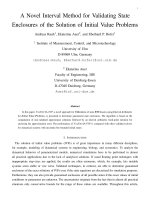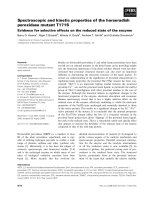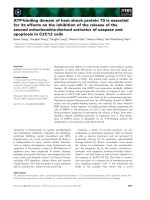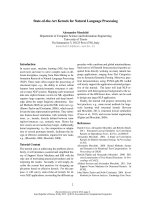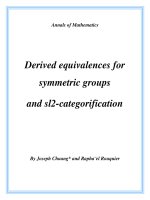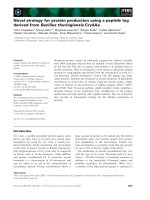Solid state fermentation (SSF) derived cellulase for saccharification of the green seaweed Ulva for bioethanol production Solid state
Bạn đang xem bản rút gọn của tài liệu. Xem và tải ngay bản đầy đủ của tài liệu tại đây (3.8 MB, 19 trang )
Solid state fermentation (SSF)derived cellulase for
saccharification of the green
seaweed Ulva for bioethanol
production
Nitin Trivedi, C.R.K. Reddy, Ricardo
Radulovich, Bhavanath Jha.
1.
Introduction
Cellulose
Cellulose, a structural component
of plant biomass, is the most
abundant feedstock used for the
production of alternative liquid
fuels, mainly bioethanol.
In which Cellulose from algae
has high Carbohydrate content,
not mixed with impurities such
as Lignin, Hemi-Cellulose and
Pectin, so it is easy to purify
Cellulose
1.
Introduction
Hydrolysis
CHEMICAL HYDROLYSIS
ENZYMATIC HYDROLYSIS
Acid hydrolysis results in the
production of some non-sugar byproducts
Enzymatic
hydrolysis
indeed presents a green
approach
1.
Introduction
Objectives
In this study, we isolated
microbial strains that
Cellulaseproduce
through
Solid
State Fermentation (SSF)
and using to
product Bioethanol
product Bioethanol
2. Methods
2.1.
Microorganism
Cellulase
positive
CMC (1,5%)
then Lugol’s
Iodine
isolate
d
Degraded
Ulva
C.
sphaerospermu
m
The molecular
identification of the
fungal strain was carried
out by 18S rDNA
sequancing
2. Methods
2.2. Collection of algal
sample
Washed and
dried
Then
grind
U. fasciata
Powdered seaweed
2. Methods
2.3. SSF and optimization of parameters for Cellulase
production
Cellulase production
was optimized with:
- Moisture
- Incubation period
- pH
- temperature
250 mL Erlenmeyer
flasks containing 10g of
powdered seaweed
Mineral salt
pH 5
Fugal spore
suspension
Flasks were incubated at room
temperature for 6 days
2. Methods
2.4. Enzyme extraction and
assay
Suspend
ed
By Sodium
Acetate
buffer
Fermented
substrate
Filtered
Enzyme activity
assay:
- FPase
- CMCase
Cold
Centrifuged
The clear
supernatant
Enzyme stability
assay:
- pH
- temperature
2. Methods
2.5. Hydrolysis of algal biomass through SSF-derived
cellulase
SSF-derived
Cellulase
Cellulose from U.
fasciata
Reducing sugar
Spectrophotometric
lly using DNS
method
ORANGE
2. Methods
2.5. Hydrolysis of algal biomass through SSF-derived
cellulase
SSF-derived
Cellulase
Reducing sugar
Cellulose from U.
fasciata
Enzyme
dosage
Hydrolysis
temperature
OPTIMIZATION OF
pH
Incubation
period
Spectrophotometric
lly using DNS
method
2. Methods
2.5. Hydrolysis of algal biomass through SSF-derived
cellulase
SSF-derived
Cellulase
Reducing sugar
Cellulose from U.
fasciata
Qualitatively
analyzed using TLC
Spectrophotometric
lly using DNS
method
2. Methods
2.6. Fermentation of algal
hydrolysate
Saccharomyces
cerevositae
MTCC No. 180
Reducing sugar
(from algal hydrolysate)
Bioethanol
Using GC-MS and DNS method to
analyzed Ethanol yield and residual
reducing sugars
3. Results
3.1. Optimization of SSF for enzyme
production
Inoculated fungus with 60% moisture
content, incubated for 4 days at 25 °C
and pH 4, showed optimum enzyme
production.
3. Results
3.2. Effect of pH and temperature on cellulase activity and
stability
Enzyme activity, found to be optimal at pH 4 and 40 °C
3. Results
3.3. Hydrolysis of algal biomass through SSF-derived
cellulase
Optimization of algal
biomass with:
-
10
U/g
Enzyme
dosage
-
24h
period
- pH 4
- 40ºC
incubation
Enzyme dosage (U/g)
3. Results
3.3. Hydrolysis of algal biomass through SSF-derived
cellulase
The presence of Glucose in the
hydrolysate, determined with TLC
Standard
Glucose
Algal
Cellulose
Algal
Biomass
3. Results
3.4. Fermentation of algal
hydrolysate
4. Conclusions
The optimal conditions SSF is a dry algal
substrate containing inoculated fungus with
60% moisture content, incubated for 4 days
at 25 °C and pH 4
The optimal conditions for fermenting
aldal biomass are 10 U/g enzymes,
incubation period of 24 h, hydrolysis
temperature of 40 °C and pH 4
The optimum ethanol yield was
found to be 0.44g with 93.81%
conversion efficiency after 12 h of
fermentation
15
%
Thanks
!
Do you have any
questions?
CREDITS: This presentation
template was created by
Slidesgo, including icons by Flaticon and infographics &
images by Freepik
